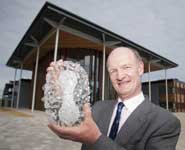The University of Bristol is a key stakeholder in the science park which is already home to the National Composites Centre where companies and Bristol academics are working together to develop new methods for the rapid manufacture of high value composite products, a major growth opportunity for the UK.
The Bristol & Bath Science Park is a 59 acre (24 hectare) site in Emerson's Green, north Bristol, which will provide up to 6,000 jobs. The Science Park will be the hub for the region's many science and technology businesses, connecting entrepreneurs, fledgling businesses and established brands with vital investors, academia and design.
Bristol and Bath form one of the six Science City regions in England, recognising its many achievements in world class scientific research, innovation and development.
To date, it has been the only Science City in the country not to have a science park and creating one is a major step forward in promoting the region's concentration of highly-skilled people as well as creating a hotbed for future innovation.
Minister for Universities and Science David Willetts said: "I am delighted to be opening the new Bristol & Bath Science Park. It will bring together universities and businesses and make the most of the region's strengths in research, helping to create new products, companies and jobs. I hope it will rapidly become a key driver of growth and innovation."
The Science Park will be the hub for the region's many science and technology businesses, connecting entrepreneurs, fledgling businesses and established brands with vital investors, academia and design.
Bonnie Dean, chief executive at the Bristol & Bath Science Park, said: “The region’s strengths in scientific research, technology and the creative industries, all of which come together at the Park, should make it a magnet for entrepreneurs and ambitious companies. The Science Park will also be a flexible and professional hub for collaboration between industry and academia.
“The capital invested to date by the South West RDA and Quantum Property Partnership has been significant, but the most important investment has been from the many individuals who have persisted in helping us reach this stage. The next new, exciting chapter begins today."
The first businesses moved into the Innovation Centre at the Park earlier this month. These include Formumetrics – a scientific consultancy that helps formulate new and improved products, YFM Equity Partners and BPE Solicitors.
The Science Park project has been designed, developed and managed by Quantum Property Partnership – a joint venture between Quintain Estates and Development plc and Aviva Investors. The South West RDA, set to close by March 2012, invested £40m which was instrumental in unlocking the project. This was the Agency's largest single investment in the South West.
The Homes and Communities Agency is now responsible for working with Quantum to develop the park. It will be managed as part of a stewardship partnership agreement with the Government covering three nationally important technology parks, including Bristol & Bath Science Park, Ansty Park in Coventry and the Advanced Manufacturing Park in Rotherham.
The first three buildings at the Park are the Forum, Innovation Centre and Expansion Space. The Forum, which is open to the public, provides a social heart for the park, with space to meet, eat, collaborate and network.
The Innovation Centre provides companies with the space they need to grow on flexible terms, accommodating their swiftly changing needs. It includes serviced office space, conference facilities, high bandwidth and excellent communications.
The Expansion Space will provide another 25,000 sq ft of space for larger businesses. It is ideal for companies that need flexible terms as well as the support of a lively business community.
The Science Park is already home to the National Composites Centre, which is supported by the University of Bristol. The Centre brings together companies and academics to develop new methods for the rapid manufacture of high value composite products, which is a major growth opportunity for the UK.
In March this year, the Government announced that the National Composites Centre is to be a partner in one of the country's first Technology Innovation Centres (TICs). This is an indication of the strength of the region's research and manufacturing capability in advanced materials.
